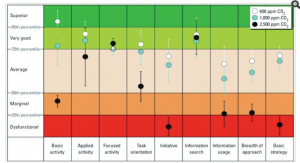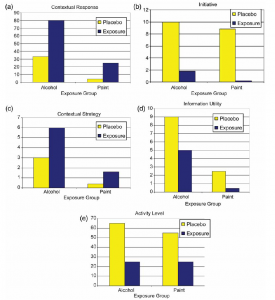Background
It is widely recognized that there is a significant relation between indoor air quality and human productivity. Workers exposed to poor air quality may get tired easily, find it difficult to concentrate or even get sick, resulting in less productivity and thus probably remarkable financial loss for employers since staff costs typically occupies about 90% of a business´ operating costs, much higher than energy costs (roughly 1%). It is estimated that 2-4% performance loss may be created by poor indoor air quality (IAQ). In contrast, large annual saving and productivity gains can potentially achieved by improved IAQ as summarized in Table. 1. It is also found that 40 dollars per person per year can be saved and working performance can be increased by 8% via doubling the ventilation rate in all climate zones investigated (MacNaughton et al., 2015). Therefore, it is worth studying in details factors associated with indoor air quality in order to create a pleasant working environment.
Table 1: Estimated potential productivity gains from improvements to indoor environments (Fisk & Rosenfeld, 1997)

Which components of indoor environment affect productivity?
Carbon Dioxide
Carbon dioxide can have a significant impact on human health and productivity. It is known that exposure to high concentration of carbon dioxide can be extremely harmful to humans with 50,000 ppm leading to signs of intoxication, 100,000 ppm causing unconsciousness and 250,000 ppm resulting in death (Lipsett, Shusterman, & Beard, 1994). On the other hand, a chamber experiment ran in 2012 found that exposure to carbon dioxide at 3,000 ppm and for a few hours makes it difficult to concentrate (Kajtár & Herczeg, 2012). It is obvious that lower carbon dioxide generally is related to better performance. Compared to carbon dioxide at 600 ppm, performance on 6 of 9 scales was reduced moderately at 1000 ppm, and performance on 7 of 9 scales was greatly reduced at 2500 ppm (Figure.1). Note that a carbon dioxide with a level of 2500 ppm is rarely seen in most working environments.

Figure. 1 Impact of carbon dioxide on human performance. In this experiment, 22 participants were exposed to CO2 at 600, 1000, and 2500 ppm, and at the end of each period took a test measuring decision making performance, health symptoms, and perceived air quality. Activities from left to right denoting 1 to 9 respectively (Satish, et al. 2012).
Relative humidity (RH)
Meta data analysis shows that relatively dry air can increase eye dryness (p<0.028) and eye irritation (p<0.005), as well as reduce productivity by experiments of conducting three office tasks (text-typing, p < 0.0002; proofreading, p < 0.03 ; and serial addition of two 2-digit numbers appearing on a computer screen, p < 0.04) under 4 RH conditions respectively (5/15/25/35%) (Wyon et al., 2003). A high relative humidity may also affect thermal comfort and lead to productivity loss (R. Kosonen and F. Tan, 2004). A suitable range for RH is within 40% and 60%.
Temperature
Maximal performance can be achieved in an optimal thermal condition while an indoor temperature deviating from the optimal value leads to a decrease in performance (Figure. 2). However, the value of an optimal temperature differs from task to task. For example, complex and creative task may require a higher suitable temperature than the others (William J. Fisk & Rosenfeld, 1997). Individual difference in temperature sensitivity may also need to be taken into account. Therefore, performance may be increased by making individual control of local thermal setting available. When it comes to the mechanism how temperature affects human productivity. Thermo-physics of the heat exchange between a worker and his surrounding environment may provide an explanation: Under an environment with a high temperature, the blood vessels would normally vasodilate, thereby leading to a larger blood flow through the skin and at higher thermal load one begins to perspire. In the absence of conscious effort, the human body might tend to adapt through lowering of internal heat production and this reduces or even avoids perspiration. This subconscious behavioural adjustment could mean a lower arousal and thus results in a slower work rate (R. Kosonen, F. Tan, 2004).

Figure 2: Impact of temperature on relative performance (maximum performance is set to 1) (Seppanen et al., 2006)
Volatile Organic Compounds (VOCs)
The sources of VOCs are various, such as cleaners, air fresheners, dry cleaned clothing, and building materials/furnishing (EPA, 2015). A significantly negative correlation between VOCs and human productivity is found among studies. It is shown that a newly painted room can damage the cognitive ability of occupants in a similar way how alcohol does (Figure. 3). However, it not clear yet which compounds among VOCs can make such an effect and their relative contribution to a decrease in human productivity. Hence, a further study is required to obtain an understanding regarding the impact of VOCs.
Figure. 3 Examples of decision making parameters: alcohol and paint. (Satish et al., 2013).
Conclusion
Some effective measurements may be required in order to obtain a suitable working environment, such as reducing/avoiding emission in VOCs, maintaining an optimal value of temperature and relative humidity, increasing ventilation to maintain a relatively low level of carbon dioxide indoors. On top of that, there are also other factors affecting indoor air quality, such as presence of carpet (may related to PM) and new electronic products such as new laptops (may related to heat emission into the air) and printers (related to ozone oxidation).

